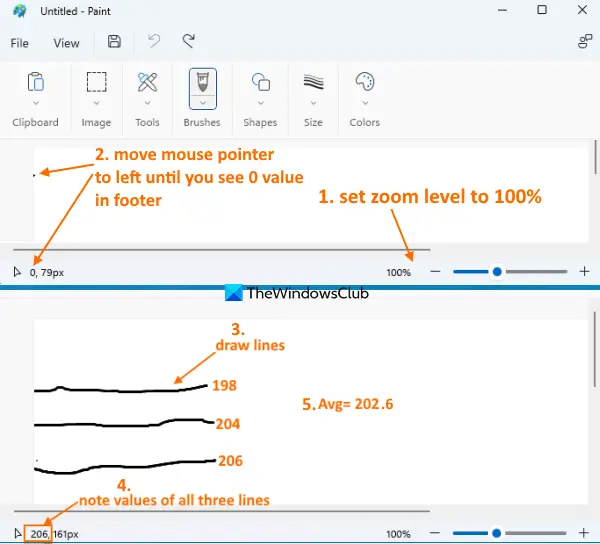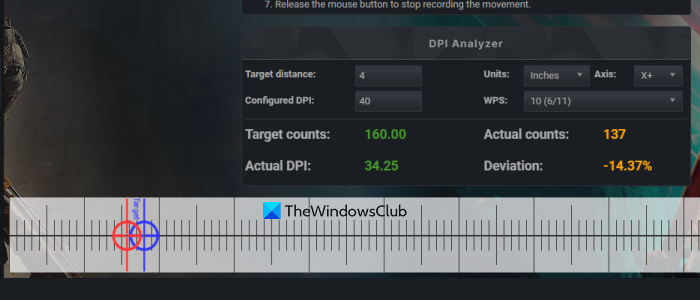In this post, we will help you how to check the mouse DPI (or sensitivity) on your Windows 11/10 computer. DPI (dots per inch) or CPI (counts per inch as referred by some manufacturers) is the standard for measuring mouse sensitivity. The mouse pointer speed or cursor speed depends on mouse DPI. The more the DPI numbers are, the higher will be the mouse sensitivity to cover the desktop screen which ultimately affects or increase/decrease the cursor speed.

Though the pointer speed can be adjusted easily as per user requirements using mouse settings, there are some tasks (like playing some game, graphic designing, etc.) where mouse precision is needed. Therefore, the requirement to check mouse DPI is needed so that one can adjust the sensitivity level and pointer speed accordingly.
How to check Mouse DPI in Windows 11/10
The list below covers different options to help you check mouse DPI or sensitivity in a Windows 11/10 computer. Once you get the correct mouse DPI for the task you need to cover, you can use a dedicated button present in your mouse model (if available) to adjust the mouse DPI or adjust the pointer speed in other ways (like mouse driver software or tool/game settings). Available options to check mouse DPI are:
- Check Manufacturer’s Website
- Using MS Paint
- DPI Analyzer tool.
Let’s check all these options.
1] Check the Manufacturer’s Website

The best option to check the maximal and/or minimal number of DPIs supported by your mouse model is by checking the manufacturer’s website. You can open the product page on the manufacturer’s website and then find the optical tracking DPI information under the technical specifications section or Specs & details or similar section of the product page. Other online sources can also provide you with such information.
Or else, you can also check the product information in the packaging box or a hard copy of product details (user documentation) if available. This option is indeed helpful but it doesn’t help you calculate the sensor accuracy or mouse DPI. For that, you can check the other options.
2] Using MS Paint

This is an interesting and useful way to check mouse DPI on Windows 11/10. You can use Microsoft Paint to calculate the mouse DPI. The output may not be entirely accurate but you will get a pretty good answer or an average value of mouse DPI. Here are the steps to check mouse DPI using MS Paint:
- Open MS Paint using the Start menu, Search box, or some other preferred way
- Set the zoom level to 100%
- Select a brush
- Move the mouse cursor to the left section unless you see a zero in the footer (on the bottom left part of MS Paint). You can use the left arrow key to precisely move the cursor or pointer to 0. This number will change when you move the mouse cursor to the right
- Now press and hold the left mouse button and move the mouse cursor to 2 to 3 inches to the right to draw a line. Try to draw it as straight as possible
- Note down the value that appeared in the footer (the first value)
- Repeat step 5 and 6 two more times
- Now you have 3 values when you moved the mouse cursor from 0 to the result values
- Calculate the average of those three values.
That average value will be your mouse DPI.
Related: How to Enhance Mouse Pointer Precision in Windows
3] DPI Analyzer tool

There is an online tool called DPI Analyzer that is available specifically for checking the mouse DPI. This tool is handy to check the actual DPI with or without knowing the configured DPI. This option also requires a bit of paperwork. Let’s check the steps:
- Open this DPI Analyzer tool from mouse-sensitivity.com
- Use paper and draw inches and cm lines just like you see on a scale/ruler. That paper will work as your mousepad to correctly measure your mouse movement (when you will move your mouse to right or left)
- Now, use the given options of this DPI Analyzer tool. These include:
- Configured DPI: Enter the current mouse DPI value (for accuracy) if you know it. Otherwise, leave this option
- Units: Set it to inches or Cm
- Target distance: How far you will be moving the mouse
- Axis: X+ (for moving to the right side) or X- (for moving to the left side).
Now, press and hold the red crosshair icon present on the tool page on the bottom section and try to move it to the target value. Also, keep a look at the paper (your mousepad) to see how far your mouse is traveled. Release the left mouse button.
This will show you the result. You will be able to check what was the target count and the actual counts. Based on the actual counts, your actual DPI value will be visible in the result.
After this, you can change the mouse DPI or pointer speed and repeat this process until the actual counts and target counts are met as per the expectations, which will ultimately show the actual DPI value you should be using for a particular task.
There are some other similar DPI analyzer tools like Mouse DPI Calculator, Mouse Sensitivity Calculator, etc., to check mouse DPI. Each tool works differently.
Hope this helps.
Also read: How to change Touchpad Sensitivity in Windows 11/10?
How to change Mouse DPI in Windows 11/10?
You can change the sensitivity of the mouse in the Settings app. Open Settings > Bluetooth and Devices > Mouse > Additional mouse options and switch to the Pointer Options tab. Then, adjust the speed of your mouse with the slider under Motion on a high-resolution screen. You may also turn off Enhance pointer precision. You can also adjust the sensitivity in the video game itself or use the DPI changer button on your gaming mouse.
How do I get my mouse to 800 DPI?
If your mouse contains DPI on-the-fly buttons, then use them to set your mouse to 800 DPI or another value if possible. A few gaming mouse models also come with dedicated driver software that you can download from the official website and then open that software where you will find a section related to DPI settings. Use that section to check the current DPI and change the mouse DPI. In other cases, you can use mouse settings on your Windows 11/10 computer to change pointer speed and then use some DPI analyzer tool to calculate the actual or average mouse DPI.
Read next: How to reset Mouse settings to default in Windows.